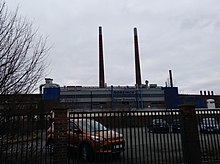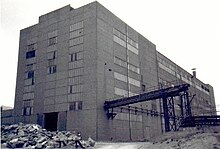Harlingerode zinc works
The zinc smelter Harlingerode , between the Goslar district of Oker and the Bad Harzburg district of Harlingerode am Harz ( Lower Saxony ), was an industrial company for the production of metallic zinc from ores and recycling raw materials . It existed from 1936 to 2000 and was the largest and most modern zinc smelter in Germany from 1948 to 1970.
The company belonged to the Preussag Group and was located in the immediate vicinity of the Oker lead-copper works and the Oker zinc oxide works .
geography

The building complex is located west of Harlingerode on the southern edge of the Cold Field , a culturally grown heather landscape today characterized by heavy metal turf and grass. To the south of it, the country road ( Kreisstraße K 70 ) crosses the site and continues from here to the neighboring villages. Further south, beyond the Heiligenholz, is the Langenberg , a limestone hill and a former quarry that is geologically recognized throughout Europe . To the north of it is the Oker – Bad Harzburg railway line , which was once directly connected to the Zinkhütte with the Oker Ost train station .
history
In order to realize their war preparations and self-sufficiency efforts , the National Socialists planned to double the mining and smelting production in the Harz. For this purpose, the lead-zinc mine of the same name near Goslar was expanded as part of the so-called Rammelsberg project. The use of the flotation technology, which was new at the time, made it possible to produce a zinc concentrate for the first time . To smelt the zinc concentrate, a new zinc smelter was to be built next to the Unterharzer ironworks in the Harlingerode district.
Construction and commissioning 1935 to 1945
In 1935, construction work on the zinc smelter on the green meadow began by the Unterharzer Berg- und Hüttenwerke GmbH . The well-known industrial architects Fritz Schupp and Martin Kremmer were commissioned to design the building . The New Jersey Vertical Retort process from New Jersey Zinc Co. in Palmerton (USA) was selected as the metallurgical production process . In this process, the zinc ore was first desulfurized in a roasting hut and the resulting zinc oxide was then reduced to vaporous zinc in standing muffles ( retorts ) with carbon.
The arrangement of the buildings was based on air protection considerations, and a large part of the machines and devices were designed redundantly in duplicate . As early as December 30, 1936, the first zinc metal was tapped in the furnace house West . The entire expansion could not be completed because of the outbreak of war and the associated shortage of materials and personnel. Eastern European forced laborers were also used during the war. After the occupation by the Allies in April 1945, operations came to a standstill.
Restart and expansion from 1945 to 1970
The ovens were restarted in December 1945. By 1953, all of the originally planned systems could be completed and put into operation. A phase of constant expansion and improvement of the metallurgical processes followed. This enabled production to be increased continuously. Between 1958 and 1959 the highest number of employees was reached with over 1,000 employees. In 1967 Preussag took over the Unterharzer Berg- und Hüttenwerke, the Harlingerode zinc smelter became part of the Harz smelting works .
Problems arose from emissions, which reached records from the 1950s onwards as part of the Korean War and the associated increases in production. The heavy metal dusts caused burns on green parts of plants in the area during the growing season. Some cattle died in agony because the green fodder was subject to heavy loads. The reason for this was that, after ongoing protests by the population in Harlingerode and Göttingerode, not far to the southeast, filtering measures were taken in the 1960s and the main chimney was raised.
Metal price drop and decline 1970 to 1988
At the beginning of the 1970s, world market prices for metals continued to fall. Zinc production was also affected. Initially, attempts were made to counter this trend by increasing production and rationalization measures. By expanding both furnace houses to a total of 46 furnaces in 1980, just over 100,000 t of metallurgical zinc could be produced.
At the beginning of 1980, a report by the Öko-Institut in Freiburg im Breisgau attracted media attention when the long-standing environmental pollution caused by the Harz ironworks was discussed. Among other things, Der Spiegel took up the topic in an article published on March 17, 1980. In 1981 the decision was made to shut down one of the two kiln houses ( east ) and the roasting hut and only use recycling materials ( secondary raw materials ) instead of ores . This was also a reaction to the stricter environmental requirements and was accompanied by the construction of new filter systems. However, when the set economic goals were not achieved, the official cessation of operations took place together with the closure of the Rammelsberg mine on June 30, 1988. By then 2.8 million tons of zinc had been produced. Up to 2000, up to ten ovens were operated as mini-huts to feed the adjacent zinc white and zinc dust plant.
Current condition

On the company premises on Landstrasse in Harlingerode, there is still the furnace house West with most of the equipment and the 20-day warehouse ( primary stock ) with the associated grinding and mixing house . These buildings lie fallow and are not open to the public.
The administration building is used by the successor companies of the Unterharzer Hütten. The fine zinc plant is now the operating building for zinc white production ( Norzinco GmbH). There are still some workshop and ancillary buildings between the still standing hut buildings and the Electrocycling GmbH site . In the background, the clearing ash dump , which has now been covered, rises as a contaminated site. Over 1 million tonnes of zinc smelting residues are stored there.
Another step towards the remediation of contaminated sites was made by the acquisition of an expansion area by Electrocycling in 2018 in connection with an area and redevelopment plan for the approximately three hectare area.
literature
- Jürgen Feiser: Chronicle of the Okerhütte 1527 - 1970 . Manuscript, Goslar 1971 (unpublished).
- Kunibert Hanusch: The lower Harz metal works in the 19th and 20th centuries - Chronicle of a change . 1st edition. World Heritage Rammelsberg, Goslar 2005, ISBN 3-9809704-1-8 .
- Lothar Klappauf et al .: On the trail of an early industrial landscape . Lower Saxony State Office for Monument Preservation, Hameln 2000.
- Wolfgang Mehner: History of lead and copper production on the lower Harz . Harz-Metall GmbH, Goslar 1993.
- Wolfgang Mehner: History of zinc metallurgy on the Harz: a chronicle of zinc production from 1900-1990 . 2nd Edition. Harz-Metall GmbH, Goslar 1995.
- Franz Pawlek: Metallurgy . Walter de Gruyter & Co., Berlin 1982, ISBN 3-11-007458-3 .
- Franz Rosenhainer: The history of the Lower Harz metallurgy from its beginnings to the establishment of Communion in 1635 . Contributions to the history of the city of Goslar, Goslar 1968.
- Zinc "Harz" - Zinc extraction at the Harlingerode zinc works . Unterharzer Berg- und Hüttenwerke, Goslar 1956.
Individual evidence
- ^ Wilhelm Baumgarten: Mitgestalten. The larger Bad Harzburg . P. 108f.
- ^ Harald Meier, Kurt Neumann: Bad Harzburg. Chronicle of a city. Pp. 649, 661.
- ↑ Der Spiegel : “At night everything comes down” . March 17, 1980. Retrieved December 28, 2019.
Web links
Coordinates: 51 ° 54 ′ 31 ″ N , 10 ° 29 ′ 47 ″ E






